Carnamah Post Office
Virtual Museum : Macpherson ●
Railway ●
Farms ●
War ●
Schools ●
Power ●
Roads ●
Business ●
Milk ●
Tea ●
Books ●
Toys

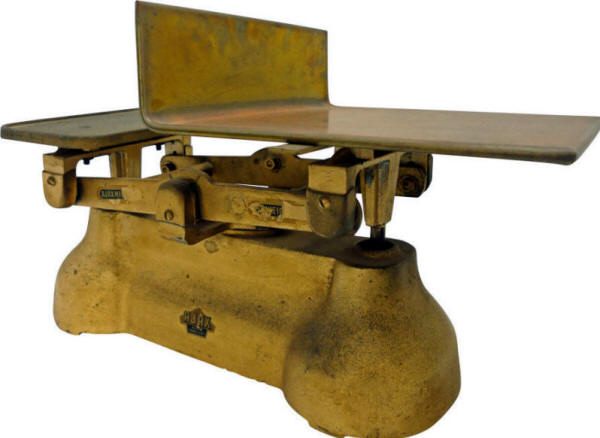
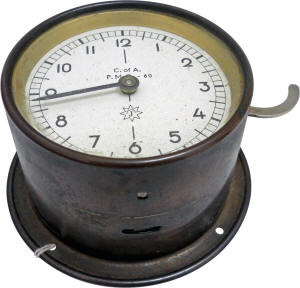
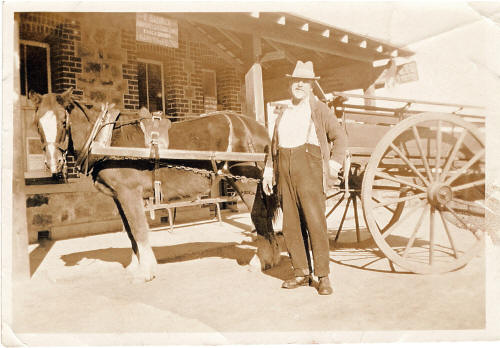
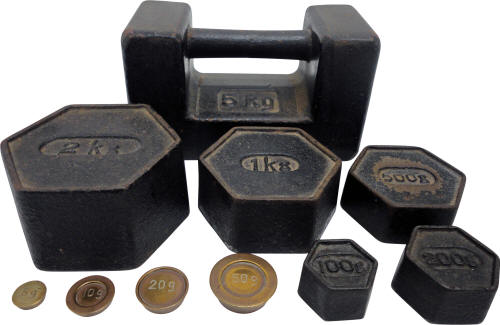
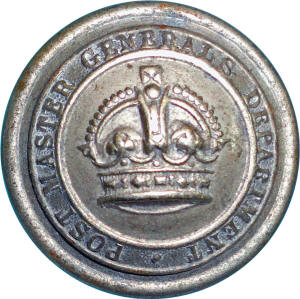
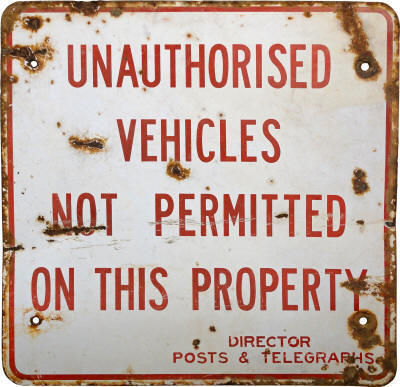
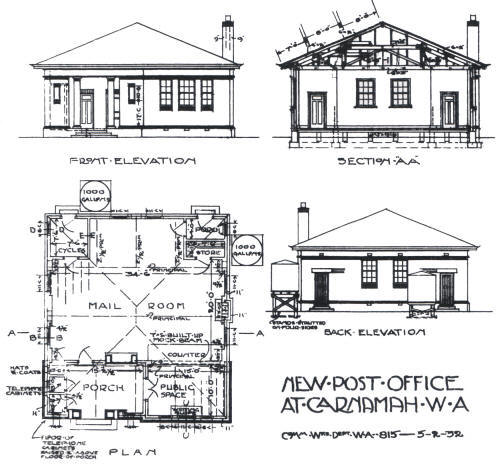
For many years letters to and from
Carnamah were collected and delivered by a mailman who travelled
between Perth and Geraldton on a horse.
Following the completion of the Midland Railway in 1894 the mail travelled on trains. It was then managed by the Macpherson family from an outbuilding of their homestead Carnamah House.
The post office was later moved to the railway station, two different general stores and then to a rented building. In the 1920s the population of Carnamah rapidly increased and this resulted in more letters, parcels and telegrams. The people of Carnamah needed a proper postal service and in 1925 began campaigning for an official post office building.
Following the completion of the Midland Railway in 1894 the mail travelled on trains. It was then managed by the Macpherson family from an outbuilding of their homestead Carnamah House.
The post office was later moved to the railway station, two different general stores and then to a rented building. In the 1920s the population of Carnamah rapidly increased and this resulted in more letters, parcels and telegrams. The people of Carnamah needed a proper postal service and in 1925 began campaigning for an official post office building.
Upon Completion in 1932
"It is an attractive and commodious brick building, excellently appointed within. It gives to Carnamah postal facilities enjoyed by very few country towns of equal size."
-- The Carnamah-Three Springs Times & Arrino Advertiser
"It is an attractive and commodious brick building, excellently appointed within. It gives to Carnamah postal facilities enjoyed by very few country towns of equal size."
-- The Carnamah-Three Springs Times & Arrino Advertiser
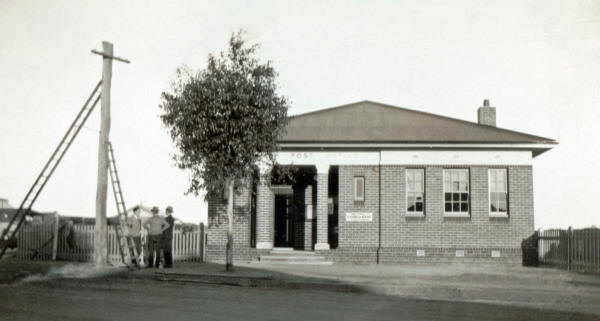
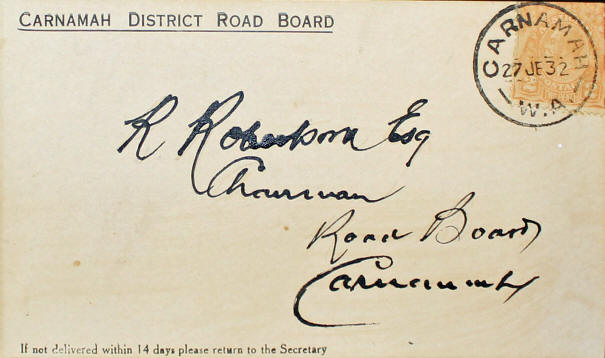
The very first letter!
Federal senator Patrick J. Lynch officially opened the post office on 30 June 1932. After unlocking the door the first letter was posted to Richard Robertson, the chairman of the Carnamah District Road Board.
The post office also included Carnamah's telephone exchange prior to telephones becoming automatic. Operators working at the exchange had to manually connect and end all local calls by moving plugs and switches.
Federal senator Patrick J. Lynch officially opened the post office on 30 June 1932. After unlocking the door the first letter was posted to Richard Robertson, the chairman of the Carnamah District Road Board.
The post office also included Carnamah's telephone exchange prior to telephones becoming automatic. Operators working at the exchange had to manually connect and end all local calls by moving plugs and switches.
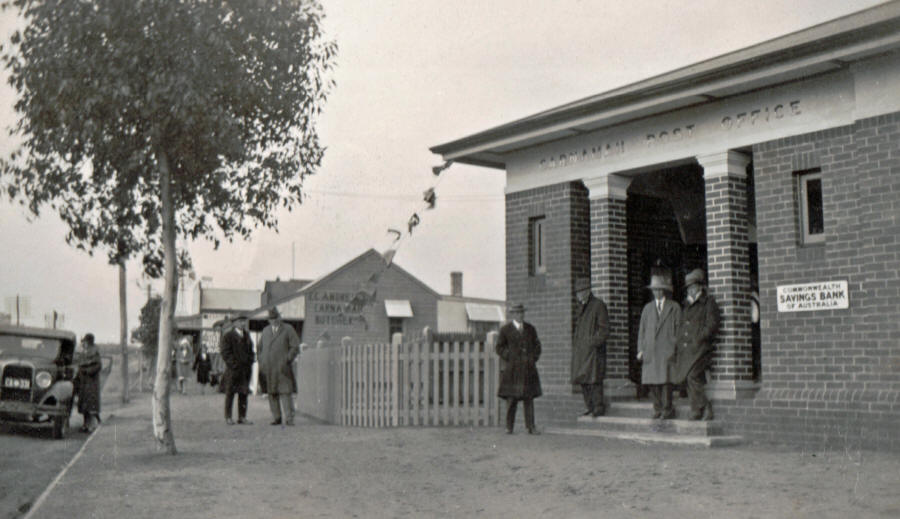
Carnamah Post Office on Opening Day
"Twenty years ago the land was the
undisturbed home of the kangaroo and emu; now it is the scene of
many happy homes. Immense strides have been made of late years in the
way of bringing people into closer communication with each other.
The old settlers had to wait for long periods before receiving a
message from their relatives, but it was now possible to communicate
with the ends of the earth in a few seconds with very little
trouble.” -- Senator Patrick J. Lynch at the opening in 1932
Right: Complimentary Dinner
booklet
The building and opening of the official post office in Carnamah was a significant occasion in the district's history.
The Carnamah District Road Board celebrated with a dinner at the Carnamah Hotel on the evening of the opening. They invited visiting government officials and representatives of local organisations and neighbouring districts.
The celebratory dinner was enjoyed so much that Capt. John W. Jones of Marchagee suggested they arrange a raiding party to demolish the new post office -- so they'd get to enjoy another dinner!
Below: Menu and toast list from the Complimentary Dinner booklet
The building and opening of the official post office in Carnamah was a significant occasion in the district's history.
The Carnamah District Road Board celebrated with a dinner at the Carnamah Hotel on the evening of the opening. They invited visiting government officials and representatives of local organisations and neighbouring districts.
The celebratory dinner was enjoyed so much that Capt. John W. Jones of Marchagee suggested they arrange a raiding party to demolish the new post office -- so they'd get to enjoy another dinner!
Below: Menu and toast list from the Complimentary Dinner booklet
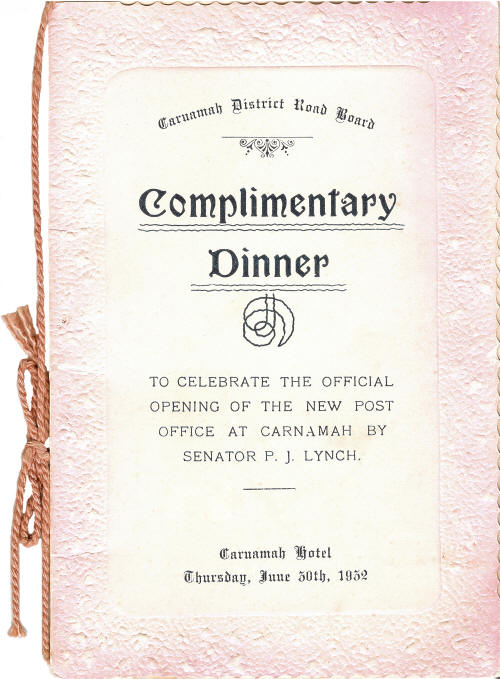
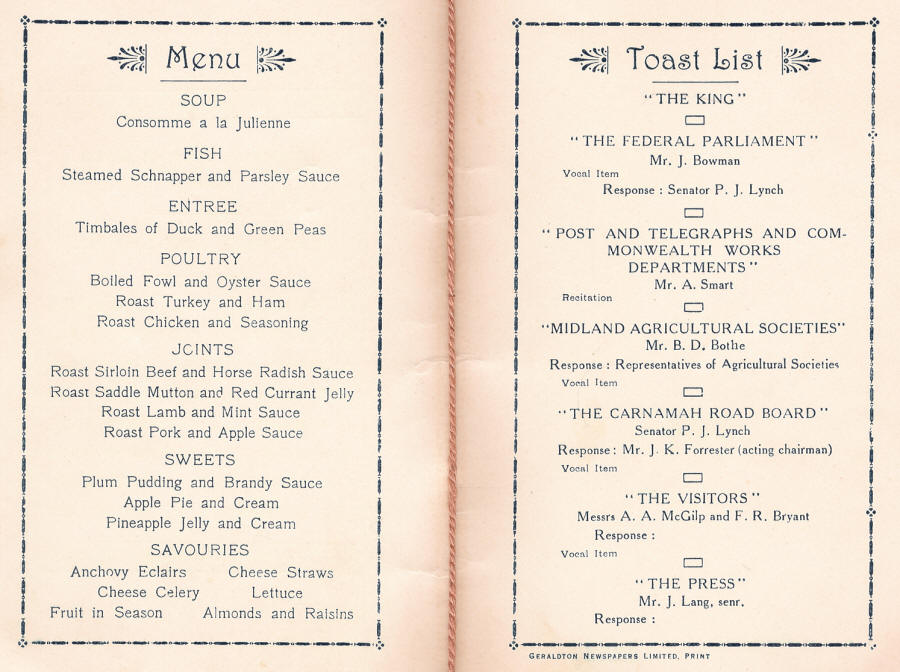
Right: Mail porter Robert Palfreyman
Mail had to be carted between the post office and railway station multiple times each week. For many years this task was contracted to the local carrier.
"They had a carrier in town – a chap by the name of Bob Palfreyman. He had an old horse and cart he used to do the carrying with. I was always amazed. After he had delivered his stores up the street, he’d walk down the footpath to the railway station and his horse would walk down the road alongside him. He’d go up the south side of the war memorial and the horse would go up the north side. He’d just walk up the steps of the station which had a porch and a waiting room, and this horse would go up, turn around and back into the platform." – Donald E. Reynolds
Mail had to be carted between the post office and railway station multiple times each week. For many years this task was contracted to the local carrier.
"They had a carrier in town – a chap by the name of Bob Palfreyman. He had an old horse and cart he used to do the carrying with. I was always amazed. After he had delivered his stores up the street, he’d walk down the footpath to the railway station and his horse would walk down the road alongside him. He’d go up the south side of the war memorial and the horse would go up the north side. He’d just walk up the steps of the station which had a porch and a waiting room, and this horse would go up, turn around and back into the platform." – Donald E. Reynolds
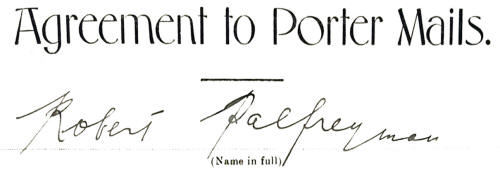

1932 Imperial Balance Scales
Larger letters and small parcels were placed on the right side and weights on the left. Weights were added and removed until the two sides of the scales balanced - which then revealed that the letter or parcel weighed as much as the weights on the other side.
Like today, the weight of an item was used to calculate postage charges.
Larger letters and small parcels were placed on the right side and weights on the left. Weights were added and removed until the two sides of the scales balanced - which then revealed that the letter or parcel weighed as much as the weights on the other side.
Like today, the weight of an item was used to calculate postage charges.

1973 Metric Weights
The above scales were used at the post office from its opening in 1932 using imperial weights that measured in pounds and ounces. New scales were used from 1973 that used metric weights, which are in kilograms and grams.
The above scales were used at the post office from its opening in 1932 using imperial weights that measured in pounds and ounces. New scales were used from 1973 that used metric weights, which are in kilograms and grams.

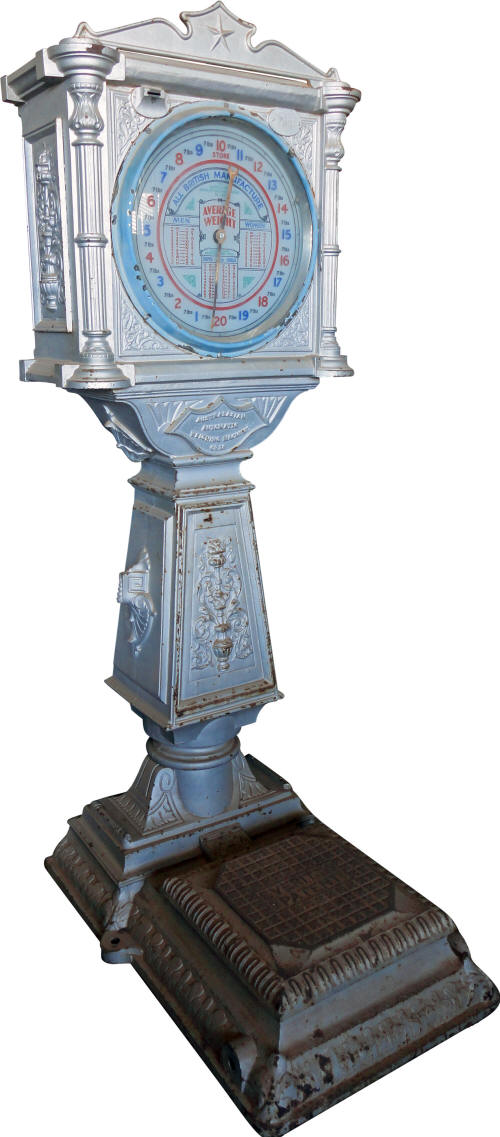
Penny-in-the-Slot Weighing Machine
When the Australian colonies federated to form the Commonwealth of Australia in 1901 their post and telegraph departments were merged to form the national Postmaster General's (PMG) Department.
In 1926 the Australian Automatic Weighing Machine Company made an arrangement with the PMG Department that allowed them to put their weighing machines outside post offices around Australia. In return, the company agreed to give the PMG a quarter of the money made from the scales - which cost a penny to use.
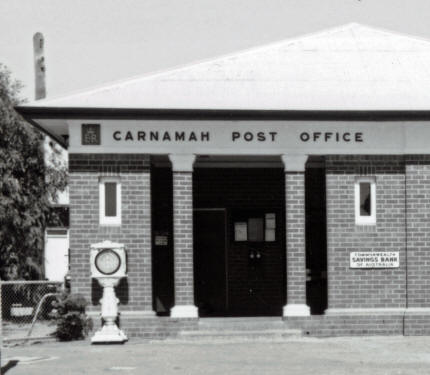
When the Australian colonies federated to form the Commonwealth of Australia in 1901 their post and telegraph departments were merged to form the national Postmaster General's (PMG) Department.
In 1926 the Australian Automatic Weighing Machine Company made an arrangement with the PMG Department that allowed them to put their weighing machines outside post offices around Australia. In return, the company agreed to give the PMG a quarter of the money made from the scales - which cost a penny to use.

One of the weighing machines was put outside the Carnamah Post
Office in 1939. As many people didn't have household scales,
they would insert a penny, step on the scales and see how
much they weighed! The scales revealed the weight in pounds and
ounces and on its face had listed the average weights for women,
men, girls and boys.
PMG Uniform Button
The man in charge of the post office and its staff was known as the postmaster. Other staff included postal clerks who served at the counter and processed mail. There were also two to three telephonists who manually connected all telephone calls within, to and from Carnamah. A night officer was employed to man the telephone exchange through the night.
The man in charge of the post office and its staff was known as the postmaster. Other staff included postal clerks who served at the counter and processed mail. There were also two to three telephonists who manually connected all telephone calls within, to and from Carnamah. A night officer was employed to man the telephone exchange through the night.

Stamps!
Stamps have long been used with postal services to mark mail with the date, where it was posted from and various other notifications.
This stamp holder, stamps and inkpad were all used at the Carnamah Post Office. The T-stamp (for tax) was stamped on letters and parcels sent with insufficient postage.
The two stamps at the bottom read Please Advise Correspondent of Your Correct Postal Address and Not Over One Hundred Dollars.
Stamps have long been used with postal services to mark mail with the date, where it was posted from and various other notifications.
This stamp holder, stamps and inkpad were all used at the Carnamah Post Office. The T-stamp (for tax) was stamped on letters and parcels sent with insufficient postage.
The two stamps at the bottom read Please Advise Correspondent of Your Correct Postal Address and Not Over One Hundred Dollars.
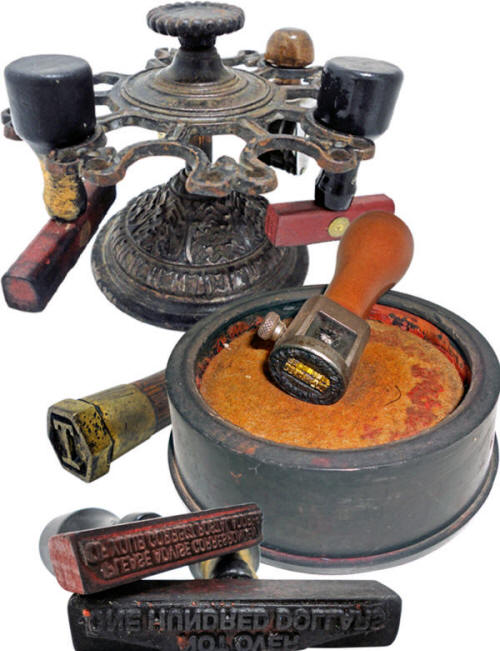
Stevenson Screen
This Stevenson Screen sat in the yard of the post office from 1932 until 1999. It contained thermometers that were used to measure Carnamah's minimum and maximum temperature each day. This information, along with how much rain had been received, was passed onto the Bureau of Meteorology.
The highest maximum in Carnamah was 48.1 degrees Celsius on 23 January 1980. The coldest minimum was on the morning of 2 July 1948, when it was minus two degrees.

This Stevenson Screen sat in the yard of the post office from 1932 until 1999. It contained thermometers that were used to measure Carnamah's minimum and maximum temperature each day. This information, along with how much rain had been received, was passed onto the Bureau of Meteorology.
The highest maximum in Carnamah was 48.1 degrees Celsius on 23 January 1980. The coldest minimum was on the morning of 2 July 1948, when it was minus two degrees.

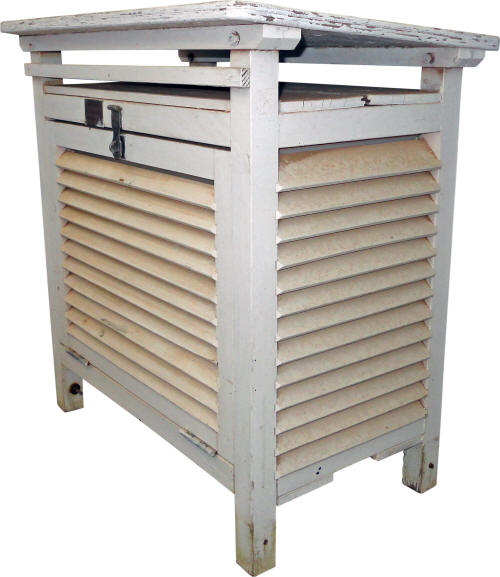
Other members of the postal staff in Carnamah were the linesman
who worked maintaining local telephone and telegraph lines. In
1934 a Linesman's Shed was built behind the post office - near
which this sign was once displayed.
Up until 1974 you had to obtain a licence from a post office for
any radios or televisions that you owned.
"The P.M.G's Department is continuing its activities against those who fail to obtain the necessary licences. Users of unlicensed radio sets are liable to HEAVY PENALTIES, including SEIZURE of their sets. Under the Australian Broadcasting Act, each person must hold a current broadcast listener's licence for each set in his possession, whether in the home, place of business, holiday residence or motor car."
-- The West Australian, 15 May 1948
"The P.M.G's Department is continuing its activities against those who fail to obtain the necessary licences. Users of unlicensed radio sets are liable to HEAVY PENALTIES, including SEIZURE of their sets. Under the Australian Broadcasting Act, each person must hold a current broadcast listener's licence for each set in his possession, whether in the home, place of business, holiday residence or motor car."
-- The West Australian, 15 May 1948
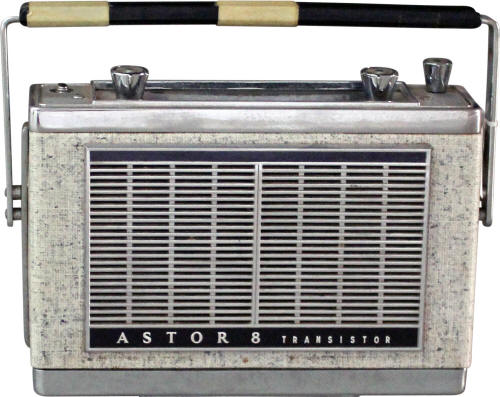
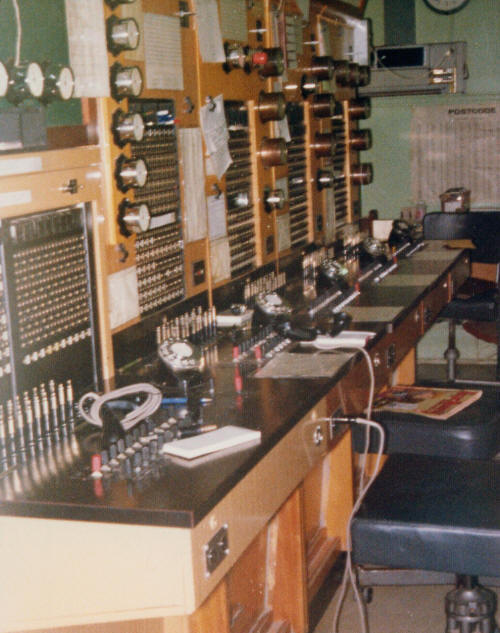
Telephone Exchange in 1976
Carnamah's telephone exchange was inside the post office until 1976 when the exchange was automated. This meant telephonists were no longer needed to respond to, connect and disconnect calls.
Before being automated, telephone calls were timed and at certain intervals the telephonist would interrupt the conversation to ask the caller if they wished to end the call or continue.

Carnamah's telephone exchange was inside the post office until 1976 when the exchange was automated. This meant telephonists were no longer needed to respond to, connect and disconnect calls.
Before being automated, telephone calls were timed and at certain intervals the telephonist would interrupt the conversation to ask the caller if they wished to end the call or continue.


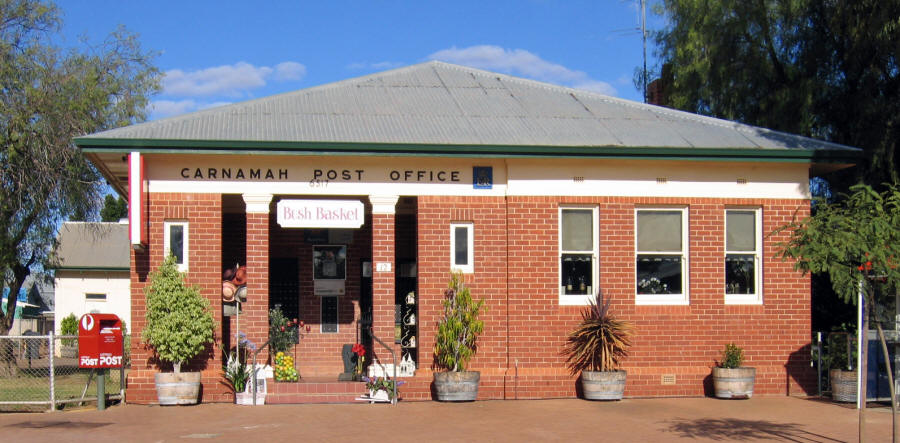
Carnamah Post Office in 2008
The Postmaster General's Department looked after post and
telephone services across Australia until 1975. The department
was then split, resulting in the creation of Australia Post and
Telecom Australia (Telstra). In 1991 the Carnamah Post Office
was downgraded and expressions of interest were called for its
operations. Colleen W. Bennier acquired the licence to run the
post office and purchased its buildings. Since 1991 she has
operated the post office in conjunction with the Bush Basket, a
gifts and health food shop. Following the closure of the Bankwest branch in Carnamah in 1997 the post office has also
been home to a Bankwest agency.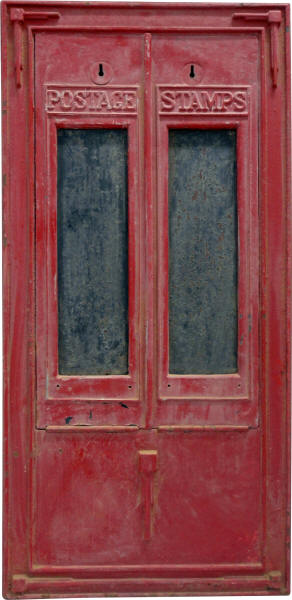
Rachel Hughes
The continuous 24 hour Telephone Exchange in Carnamah was worked in 3 shifts: 7:30 am to 12 noon & 1:30 pm to 5 pm, 12 noon to 1:30 pm & 5 pm to 10 pm and the night shift from 10 pm to 7:30 am.
Telephonists had to go outside and read the weather at 3 pm every day. Once I caused Royal Australian Air Force planes to be grounded at Geraldton. There was a strong wind at Carnamah and I reported a force 8 wind. The Air Force tried desperately to ring the Postmaster to check.
One night Win McSwain and I were on night shift and sometime after 1 am the buzzer went off indicating a call. The town electricity supply ceased at 1 am in those days. We reached for the box of matches tied to a piece of string behind the switchboard in order to light the kerosene lamp so that we could see the switchboard. The box had gone! We panicked. At the time Win was staying with Mrs Robertson at the back of the Bank of Australasia and she said that she knew that there was a box of matches in the toilet there. She ran down the street in her nightie, found the box of matches and returned to light the lamp so that the call could be answered.
Bridie Evans
I became a telephonist in Carnamah in 1946. There was only one switch board in the far end of the Post Office. Trunk calls would sometimes take hours as first booked came first. We had to interrupt close to 3 minutes and say “3 minutes. Are you extending?” If they were we had to reset the time for another 3 minutes.
Mail delivery started just after that and I can remember the postmaster sending the postman to the shops for a tin of striped paint. The postman eventually woke up!
On Thursday afternoons the Post Office and shops closed – they opened all day Saturday.
Telegrams would be rung through but if a person was not on the telephone we would deliver the telegrams after our own shift finished.
The Carnamah Exchange had been a continuous service 24/7 since 1936 and during the war when there were no boys to work the night shift they allowed two girls to work. One would be “on duty” and the other a sleeping partner. They took it week about. One night I slept there in 1942 with my sister as the regular girl was away. I was paid 4/- (40 cents). I thought all my birthdays had come at once.
In later years the exchange was moved to a room at the back of the Post Office. We finished up with five switch boards there. I filled in now and again on day shift but I also did the night shift, week about with another ex-telephonist. Before the door to the Post Office was locked at 5 pm our fold up bed would be brought out and left behind the switchboards. Our own shift started at 10 pm and finished at 7 am. Well one night I was sewing and when I went to go to bed much later, there was no bed. It was too late to ring the postmaster so I found two sheets in a cupboard (luckily it was summer) and I put them along 3 padded chairs and slept on them. The only trouble was the chairs all had castors & the middle one kept moving all night.
On the night shift we had a buzzer to wake us up when someone rang. The box with the switch was padlocked each night and opened at 7:30 am when the second girl came on. Sometimes when the 7 am girl was busy and the buzzer was too loud she would smother it with a duster. Well one night it wasn't removed when the buzzer was switched on. If a call wasn't answered promptly a hooter would go off. Well that is what happened to me one night, the hooter went and scared the living day lights out of me. My hands were shaking so much I could hardly get the plug in the hole to answer two calls. One call was the postmaster as he had heard it about 200 yards up the street and after midnight. Covering the buzzer was never allowed again!
When we had the Meckering earthquake my daughter Shirley was working on the exchange. All the shutters on the switchboard came down and also the fluorescent light fell on top of her and broke. She panicked and rang me and took off as she reckoned it was poisonous. I had to dash up and restore order.
Yvette
I can remember the large scales that were out the front of the Post Office from when I was a girl in Carnamah. You had to put a penny in them. Everybody used them as nobody had scales at home in those days.
Cyril Rayner
It was handy to get your mail from the telephonists 9 o’clock at night... In those days I had to work pretty long hours – that was before I got married. I used to ride my bike in at night. You could go to the Post Office – I never had a box – and you could tap on the door and one of the telephonists would come and you could get your mail at 7, 8 or 9 o’clock at night. It was handy. I used to get a fair bit of mail. The mail trains came up on Wednesday and Saturdays and I used to go in on those nights. I had my mother, two brothers and cousins in England, and I had a brother and sister in Canada, and besides them one or two friends, so I used to get a fair bit of mail. I used to look forward to riding in on Wednesdays and Saturdays.
I had to write back. I used to spend a fair bit of Sunday writing letters. When I left home to come out here, my brother, who was out here said: “Don’t forget to write home pretty regularly.” I always remembered that.
I used to get a paper on Wednesday and on Saturday when I went into town. You only had an oil lamp at night and it wasn't that good reading. I used to have a lot of mail to write so I didn't have that much time to do anything else. There were no fly wire doors, so insects came in. Things were pretty rough. Now you get up in the morning and you just switch the electric light on, before you had to light the fire before you could do anything.
Alex Power
I left school at 14 and went to work in Three Springs Post Office straight away. I rode my bike up from Carnamah for the week of work. It was a long bike ride, particularly as the road was not sealed. In those days the Post Office was open until 12 midday on Saturdays. On Monday holidays we had to open for one hour, so that meant I had to go up for the hour.
Everything was well sealed in the mail bags. Mail came mostly on the day trains but some came in at night. The bags were put in a locked box in the Station Master’s Office. I had a key to the box. Sorting officially started at 8:30am but mostly I started at 8am. I brought the mail across from the station in a wooden cart which had two big wheels. The bags had to be stacked carefully so that they didn't fall off. Thursday was the day for the “Wheat Grower”, “Primary Producer” and Elders. Boans’ catalogues were large and very heavy.
Three Springs was a Grade 1 Post Office.
Charles Lipscombe had come from Sandstone... and his ambition was to get an office in Perth metropolitan area. Unfortunately he was qualified only as a Postmaster, Grade 1 and there were very few such post offices in the metropolitan area. In those days all postmasters had to be qualified Morse operators so that they could send and receive telegrams. He was an excellent receiver but his sending was not really good. His hobby was radio and he built his own dual wave receiver. He was a good natured fellow with a very dry sense of humour. During drought period he would say to farmers, "It would be a fine day if it rained." I don't know that they were all that amused but they would laugh anyway.... his daughter's name was Lily... Lily was a telephonist and later in the war years worked on the counter as Postal Assistant.
Mary Clews
When I lived in Winchester from 1968 to 1974, there was no delivery of mail to Winchester. Instead each household had some sort of a box near the Chapman's farm. Anyone who went into Carnamah for supplies would also call in at the Post Office and pick up a bag of mail. On arriving back in Winchester, it was then one's duty to distribute the mail into the appropriate boxes. I can remember at least one occasion where I distributed identical letters to every box. On opening mine, I found that it said "You are one of the lucky people in Winchester to be receiving this." Of course it was from the Readers Digest. Another irony was that I received two copies, one addressed to Mrs Straiton (my former married name) and the other to Miss Foss (my maiden name).
Bill Higgins
I arrived in Carnamah in 1958. I was a Postal Clerk in Carnamah for around 18 months straight, and then went relieving as Acting Postmaster at Coorow, Three Springs and Mingenew but always returning to Carnamah after those relief periods. I would say off and on I spent three years in Carnamah, and loved every bit of it.
The Post Office was classified as a Grade 2 office, and provided full facilities for the time. But did not provide the range of agency services they do today. Counter services included the sale of postage stamps, Tax stamps on behalf of the Taxation Office, Commonwealth Savings Bank deposits and withdrawals. Town mail and telegram deliveries were provided. Telegrams were sent and received by Morse code, but this changed about twelve months after my arrival. Carnamah was also a weather reporting station providing 9am; 12noon; 3pm; 6pm observations seven days a week. Mail delivery services were also provided to householders (farmers) out at East and West Carnamah and Winchester.
Phyllis Leavy (nee John)
My first job was a telephonist at Carnamah where I worked for about six years. I can honestly say I loved that job and now when I see an old-fashioned switchboard in museums I get quite sentimental. I transferred to Perth Phonogram Section. After raising a family I then worked for Australia Post for 17 years.
Carnamah Historical Society & Museum
Pictured further below is postmaster Percy Teede and telephonist Jessie Wylie in the old Carnamah Post Office at 23 Macpherson Street in Carnamah. Please help enrich our collective history by sharing your own comment, story, memories or photos. Click here to go to the comment form or send us an e-mail to mail@carnamah.com.au
Dodgy Perth
Originally published on the Dodgy Perth website as 'Way out of line' on 21 February 2015
There are not many inviolable rules when erecting a building, but there are some. Dodgy Perth now offers you this planning tip: make sure your building is in line with the street or it will look like you don’t know what you’re doing.
Welcome to Carnamah. In 1932 the good citizens of this small Mid-West town were all excited about the new Post Office being raised by the Public Works Department.
However when the foundations were put down it was noticed that the alignment was completely wrong, and it did not fit with all the other buildings on Macpherson Street. The Government was asked to fix this problem before the building itself went up.
At first, the response was that the local Road Board had asked for it to be built like that. Which wasn’t true. Then the Government said that it was at the request of the Citizens’ Association. Which wasn’t true either. In the end, the Government simply told Carnamah that if they got any more complaints they wouldn’t build a Post Office at all. So shut the hell up country people.
The Post Office was built and opened in June 1932. With the wrong alignment. And remains just like that to this day. So when you’re next in Carnamah, raise a glass to the Postmaster General’s Department and their unorthodox approach to making friends in the regions.
The Sunday Times newspaper, 5 June 1932:
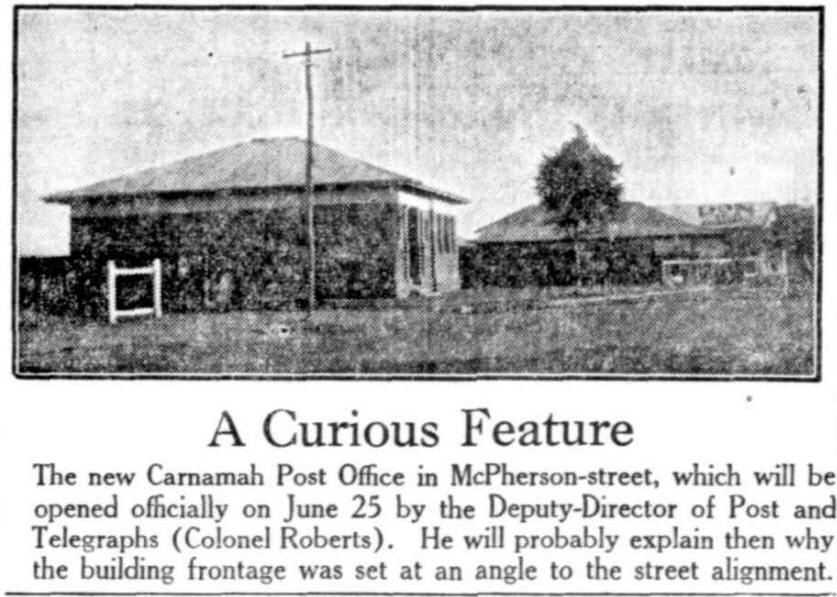
The continuous 24 hour Telephone Exchange in Carnamah was worked in 3 shifts: 7:30 am to 12 noon & 1:30 pm to 5 pm, 12 noon to 1:30 pm & 5 pm to 10 pm and the night shift from 10 pm to 7:30 am.
Telephonists had to go outside and read the weather at 3 pm every day. Once I caused Royal Australian Air Force planes to be grounded at Geraldton. There was a strong wind at Carnamah and I reported a force 8 wind. The Air Force tried desperately to ring the Postmaster to check.
One night Win McSwain and I were on night shift and sometime after 1 am the buzzer went off indicating a call. The town electricity supply ceased at 1 am in those days. We reached for the box of matches tied to a piece of string behind the switchboard in order to light the kerosene lamp so that we could see the switchboard. The box had gone! We panicked. At the time Win was staying with Mrs Robertson at the back of the Bank of Australasia and she said that she knew that there was a box of matches in the toilet there. She ran down the street in her nightie, found the box of matches and returned to light the lamp so that the call could be answered.
Bridie Evans
I became a telephonist in Carnamah in 1946. There was only one switch board in the far end of the Post Office. Trunk calls would sometimes take hours as first booked came first. We had to interrupt close to 3 minutes and say “3 minutes. Are you extending?” If they were we had to reset the time for another 3 minutes.
Mail delivery started just after that and I can remember the postmaster sending the postman to the shops for a tin of striped paint. The postman eventually woke up!
On Thursday afternoons the Post Office and shops closed – they opened all day Saturday.
Telegrams would be rung through but if a person was not on the telephone we would deliver the telegrams after our own shift finished.
The Carnamah Exchange had been a continuous service 24/7 since 1936 and during the war when there were no boys to work the night shift they allowed two girls to work. One would be “on duty” and the other a sleeping partner. They took it week about. One night I slept there in 1942 with my sister as the regular girl was away. I was paid 4/- (40 cents). I thought all my birthdays had come at once.
In later years the exchange was moved to a room at the back of the Post Office. We finished up with five switch boards there. I filled in now and again on day shift but I also did the night shift, week about with another ex-telephonist. Before the door to the Post Office was locked at 5 pm our fold up bed would be brought out and left behind the switchboards. Our own shift started at 10 pm and finished at 7 am. Well one night I was sewing and when I went to go to bed much later, there was no bed. It was too late to ring the postmaster so I found two sheets in a cupboard (luckily it was summer) and I put them along 3 padded chairs and slept on them. The only trouble was the chairs all had castors & the middle one kept moving all night.
On the night shift we had a buzzer to wake us up when someone rang. The box with the switch was padlocked each night and opened at 7:30 am when the second girl came on. Sometimes when the 7 am girl was busy and the buzzer was too loud she would smother it with a duster. Well one night it wasn't removed when the buzzer was switched on. If a call wasn't answered promptly a hooter would go off. Well that is what happened to me one night, the hooter went and scared the living day lights out of me. My hands were shaking so much I could hardly get the plug in the hole to answer two calls. One call was the postmaster as he had heard it about 200 yards up the street and after midnight. Covering the buzzer was never allowed again!
When we had the Meckering earthquake my daughter Shirley was working on the exchange. All the shutters on the switchboard came down and also the fluorescent light fell on top of her and broke. She panicked and rang me and took off as she reckoned it was poisonous. I had to dash up and restore order.
Yvette
I can remember the large scales that were out the front of the Post Office from when I was a girl in Carnamah. You had to put a penny in them. Everybody used them as nobody had scales at home in those days.
Cyril Rayner
It was handy to get your mail from the telephonists 9 o’clock at night... In those days I had to work pretty long hours – that was before I got married. I used to ride my bike in at night. You could go to the Post Office – I never had a box – and you could tap on the door and one of the telephonists would come and you could get your mail at 7, 8 or 9 o’clock at night. It was handy. I used to get a fair bit of mail. The mail trains came up on Wednesday and Saturdays and I used to go in on those nights. I had my mother, two brothers and cousins in England, and I had a brother and sister in Canada, and besides them one or two friends, so I used to get a fair bit of mail. I used to look forward to riding in on Wednesdays and Saturdays.
I had to write back. I used to spend a fair bit of Sunday writing letters. When I left home to come out here, my brother, who was out here said: “Don’t forget to write home pretty regularly.” I always remembered that.
I used to get a paper on Wednesday and on Saturday when I went into town. You only had an oil lamp at night and it wasn't that good reading. I used to have a lot of mail to write so I didn't have that much time to do anything else. There were no fly wire doors, so insects came in. Things were pretty rough. Now you get up in the morning and you just switch the electric light on, before you had to light the fire before you could do anything.
Alex Power
I left school at 14 and went to work in Three Springs Post Office straight away. I rode my bike up from Carnamah for the week of work. It was a long bike ride, particularly as the road was not sealed. In those days the Post Office was open until 12 midday on Saturdays. On Monday holidays we had to open for one hour, so that meant I had to go up for the hour.
Everything was well sealed in the mail bags. Mail came mostly on the day trains but some came in at night. The bags were put in a locked box in the Station Master’s Office. I had a key to the box. Sorting officially started at 8:30am but mostly I started at 8am. I brought the mail across from the station in a wooden cart which had two big wheels. The bags had to be stacked carefully so that they didn't fall off. Thursday was the day for the “Wheat Grower”, “Primary Producer” and Elders. Boans’ catalogues were large and very heavy.
Three Springs was a Grade 1 Post Office.
Charles Lipscombe had come from Sandstone... and his ambition was to get an office in Perth metropolitan area. Unfortunately he was qualified only as a Postmaster, Grade 1 and there were very few such post offices in the metropolitan area. In those days all postmasters had to be qualified Morse operators so that they could send and receive telegrams. He was an excellent receiver but his sending was not really good. His hobby was radio and he built his own dual wave receiver. He was a good natured fellow with a very dry sense of humour. During drought period he would say to farmers, "It would be a fine day if it rained." I don't know that they were all that amused but they would laugh anyway.... his daughter's name was Lily... Lily was a telephonist and later in the war years worked on the counter as Postal Assistant.
Mary Clews
When I lived in Winchester from 1968 to 1974, there was no delivery of mail to Winchester. Instead each household had some sort of a box near the Chapman's farm. Anyone who went into Carnamah for supplies would also call in at the Post Office and pick up a bag of mail. On arriving back in Winchester, it was then one's duty to distribute the mail into the appropriate boxes. I can remember at least one occasion where I distributed identical letters to every box. On opening mine, I found that it said "You are one of the lucky people in Winchester to be receiving this." Of course it was from the Readers Digest. Another irony was that I received two copies, one addressed to Mrs Straiton (my former married name) and the other to Miss Foss (my maiden name).
Bill Higgins
I arrived in Carnamah in 1958. I was a Postal Clerk in Carnamah for around 18 months straight, and then went relieving as Acting Postmaster at Coorow, Three Springs and Mingenew but always returning to Carnamah after those relief periods. I would say off and on I spent three years in Carnamah, and loved every bit of it.
The Post Office was classified as a Grade 2 office, and provided full facilities for the time. But did not provide the range of agency services they do today. Counter services included the sale of postage stamps, Tax stamps on behalf of the Taxation Office, Commonwealth Savings Bank deposits and withdrawals. Town mail and telegram deliveries were provided. Telegrams were sent and received by Morse code, but this changed about twelve months after my arrival. Carnamah was also a weather reporting station providing 9am; 12noon; 3pm; 6pm observations seven days a week. Mail delivery services were also provided to householders (farmers) out at East and West Carnamah and Winchester.
Phyllis Leavy (nee John)
My first job was a telephonist at Carnamah where I worked for about six years. I can honestly say I loved that job and now when I see an old-fashioned switchboard in museums I get quite sentimental. I transferred to Perth Phonogram Section. After raising a family I then worked for Australia Post for 17 years.
Carnamah Historical Society & Museum
Pictured further below is postmaster Percy Teede and telephonist Jessie Wylie in the old Carnamah Post Office at 23 Macpherson Street in Carnamah. Please help enrich our collective history by sharing your own comment, story, memories or photos. Click here to go to the comment form or send us an e-mail to mail@carnamah.com.au
Dodgy Perth
Originally published on the Dodgy Perth website as 'Way out of line' on 21 February 2015
There are not many inviolable rules when erecting a building, but there are some. Dodgy Perth now offers you this planning tip: make sure your building is in line with the street or it will look like you don’t know what you’re doing.
Welcome to Carnamah. In 1932 the good citizens of this small Mid-West town were all excited about the new Post Office being raised by the Public Works Department.
However when the foundations were put down it was noticed that the alignment was completely wrong, and it did not fit with all the other buildings on Macpherson Street. The Government was asked to fix this problem before the building itself went up.
At first, the response was that the local Road Board had asked for it to be built like that. Which wasn’t true. Then the Government said that it was at the request of the Citizens’ Association. Which wasn’t true either. In the end, the Government simply told Carnamah that if they got any more complaints they wouldn’t build a Post Office at all. So shut the hell up country people.
The Post Office was built and opened in June 1932. With the wrong alignment. And remains just like that to this day. So when you’re next in Carnamah, raise a glass to the Postmaster General’s Department and their unorthodox approach to making friends in the regions.
The Sunday Times newspaper, 5 June 1932:

Early Postmasters in Carnamah
Listed in chronological order
● "Maggie" Margaret Macpherson
● "Harry" Henry Parkin
● Olive May Parkin
● "Millie" Mildred Maud Parkin
● Albert Edward Knights
● "Dinny" Denis McCrann
● Ernest Edwin John Reimann
● "Percy" Percival Teede (pictured below)
● Hubert Roy Phillips
● Robert Henry Lambert
● Francis Xavier O'Donnell
● Barton William Edward Lloyd
● Jack Armstrong
Listed in chronological order
● "Maggie" Margaret Macpherson
● "Harry" Henry Parkin
● Olive May Parkin
● "Millie" Mildred Maud Parkin
● Albert Edward Knights
● "Dinny" Denis McCrann
● Ernest Edwin John Reimann
● "Percy" Percival Teede (pictured below)
● Hubert Roy Phillips
● Robert Henry Lambert
● Francis Xavier O'Donnell
● Barton William Edward Lloyd
● Jack Armstrong
Early Telegraph Operators in
Carnamah
● "Bessie" Elizabeth Macpherson
● "Maggie" Margaret Macpherson
Early Telephonists in Carnamah
Partial list in rough chronological order
● "Jessie" Clarice Jessie Wylie (pictured below)
● Hazel Rae Wylie
● Eileen Louise Clark
● Naomi Pearl Brady
● "Win" Winsome McSwain
● Shirley Dawn Bentley
● George Henry Low
● Dorothy Irene Brady
● Vida Emeline Whitehurst
● "Bessie" Elizabeth Macpherson
● "Maggie" Margaret Macpherson
Early Telephonists in Carnamah
Partial list in rough chronological order
● "Jessie" Clarice Jessie Wylie (pictured below)
● Hazel Rae Wylie
● Eileen Louise Clark
● Naomi Pearl Brady
● "Win" Winsome McSwain
● Shirley Dawn Bentley
● George Henry Low
● Dorothy Irene Brady
● Vida Emeline Whitehurst
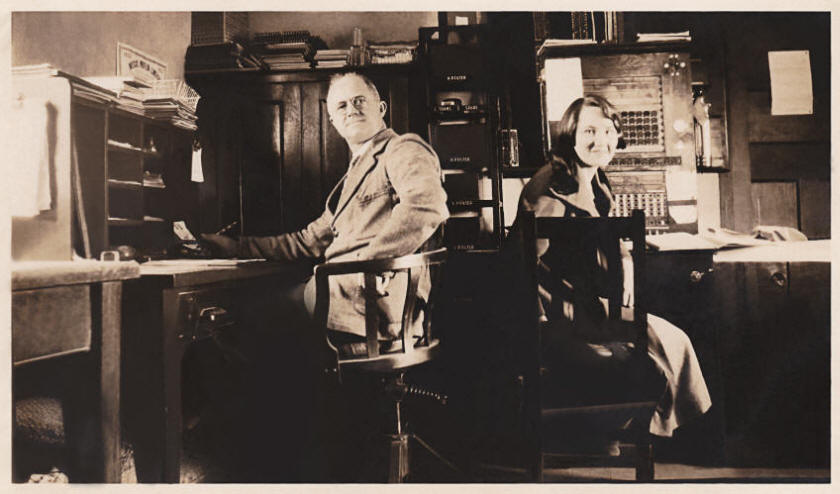
V i r t u a l M u s e u m :
Macpherson ● Railway ● Farms ● Town ● War ● Schools ● Roads ● Business ● Milk ● Electricity ● Tearooms ● Books ● Toys
Now featuring 10863 Bushranger presented by Act Belong Commit







